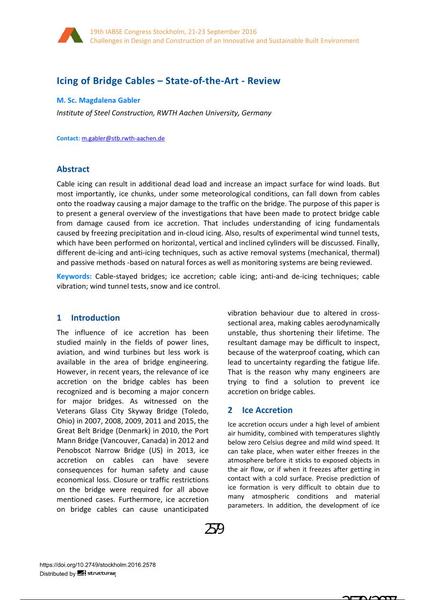Icing of Bridge Cables – State-of-the-Art - Review

|
|
|||||||||||
Détails bibliographiques
| Auteur(s): |
Magdalena Maria Gabler
(Institute of Steel Construction, RWTH Aachen University, Germany)
|
||||
|---|---|---|---|---|---|
| Médium: | papier de conférence | ||||
| Langue(s): | anglais | ||||
| Conférence: | IABSE Congress: Challenges in Design and Construction of an Innovative and Sustainable Built Environment, Stockholm, Sweden, 21-23 September 2016 | ||||
| Publié dans: | IABSE Congress Stockholm, 2016 | ||||
|
|||||
| Page(s): | 2579-2586 | ||||
| Nombre total de pages (du PDF): | 8 | ||||
| Année: | 2016 | ||||
| DOI: | 10.2749/stockholm.2016.2578 | ||||
| Abstrait: |
Cable icing can result in additional dead load and increase an impact surface for wind loads. But most importantly, ice chunks, under some meteorological conditions, can fall down from cables onto the roadway causing a major damage to the traffic on the bridge. The purpose of this paper is to present a general overview of the investigations that have been made to protect bridge cable from damage caused from ice accretion. That includes understanding of icing fundamentals caused by freezing precipitation and in-cloud icing. Also, results of experimental wind tunnel tests, which have been performed on horizontal, vertical and inclined cylinders will be discussed. Finally, different de-icing and anti-icing techniques, such as active removal systems (mechanical, thermal) and passive methods -based on natural forces as well as monitoring systems are being reviewed. |
||||
| Mots-clé: |
Ponts à haubans essais en soufflerie
|
||||
